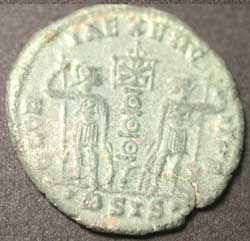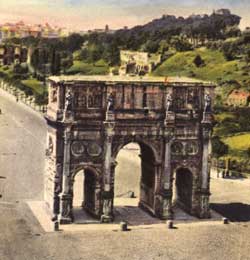Constantine | Helena >
Constantine: The Great
The use of a physical cross as a sign and symbol emerged gradually in Christian practices.
While the theology of the cross is taught by Paul and the sign of the cross for baptism and protection is reported fairly early, the use of a physical cross rarely appears before the fourth century.(1)
At that time, two events involving Constantine led to the use of a physical cross or cross form by the state, the emerging church, and Christians.
In the first event, Constantine reports having a vision of a sign, either while sleeping or seen in the sky, that came to be identified with Christ. With the vision and dream he saw the words, In Hoc Signo Vinces, "In this sign conquer", and assured his victory over Maxentius. He placed the sign at the top of his standard and on the shields of his men and won the battle of Milvian Bridge outside of Rome in 312 . (2) This victory made Constantine the emperor of the West. He surprised everyone by openly supporting Christianity. (3)
This sign, a Chi Rho, one of the monograms standing for the word Christ in Greek (XPIETOE), replaced the eagle as the military standard for the legions of the Roman Army. Known as the labarum, a term of unknown origin, over time this sign was gradually replaced by the cross.
The second event is the legend of the discovery of the original cross of Christ by Constantine’s mother, Helena.
Constantine | Helena >
Notes
- Norman Laliberte and Edward N. West, The History of the Cross (New York: Macmillan Company, 1960) 6. St. Ignasius of Antioch (d 107) is believed to have initiated the practice of signing at baptism. Peter E. Moore, "Cross and Crucifixion in Christian Iconography," Religion 4 (1974) 105, writes, "The Christian sign of the cross originates not as an allusion to the Crucifixion but in the Hebrew letter taw, which represents the name of God." Anatole Frolow, "The Veneration of the Relic of the True Cross at the End of the Sixth and the Beginning of the Seventh Centuries," St. Vladimir’s Seminary Quarterly 2, No.1 (winter 1958) AtlaReligion (22 February 2004), 14, traces the use of the shape of the cross from Paul to St. Justin then to an announcement by St. Cyprian in 248. [Return]
- Eusebius (340) "Life of Constantine,"The Conversion of Constantine, ed. John W. Eadie, (New York: Holt, Rinehart and Winston, 1971) 13-14, reports a vision and a dream. Lactantius (318) "On the Deaths of Persecutors" The Conversion of Constantine, 11-12, reports the sign appeared in a dream. This was accompanied with the direction, in hoc signo vinces, "in this sign conquer." There has been much debate over the nature of the sign. Constantine scholar Timothy Barnes believes the sign was most likely a natural event that occurred in Gaul a few years before, cited by Rosella Lorenzi, "Christianity: Came from Outer Space," Discovery News (24 July 2003), http://dsc.discovery.com/news/briefs/20030623/constantine.html (4 March 2004). The article reports the speculation of a scientist that a meteor had landed nearby, creating the sign in the sky. [Return]
- Historical assessment of Constantine is mixed. He is viewed with great praise for his support of Christianity and great suspicion due to various acts, such as the apparent execution of his son Crispus and wife Fausta. Tradition places his remains with relics of the 12 apostles in the Church of the Holy Apostles in Constantinople, the new Rome that he founded and stood as a stronghold of Christianity for over a thousand years. [Return]
|
|

|
| Conversion of Emperor Constantine, Print, 1869, Johnson, Fry & Company Publishers, New York. Sometimes the scene has a cross, sometimes a chi rho sign. Rarely depicted is the version of Constantine’s dream, as in the Stavelot Reliquary. |
|

|
| Bronze coin, Smana mint, 17 mm, c. 320 (enlarged). Constantine is the first emperor to be shown on coins without a beard since Trajan, indicating a new age. On some coins he appears to be looking up, interpreted as a way of showing his religious nature.
|
|

|
| Bronze coin, Osis mint, 17 mm, c. 337-50 (enlarged) Obverse of Roman imperial coin of Constans, one of Constantine’s sons, shows two soldiers on either side of the labarum standard. Many of these coins, used to pay the army, praise the army. The inscription on the coin is Gloria Exercitvs, "Glory to the Army.".
|
|

|
| Arch of Constantine, Rome, Postcard, c. 1950s. Completed in 315 to recognize Constantine’s victory, the arch has no reference to Chrisitianity. The inscription at the base attributes the victory to instinctu divinitatis mentis magnitudine, "by the prompting of the divinity and the emperor’s own greatness of mind."
|
|